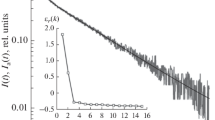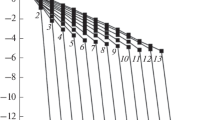Abstract
The interpretation of fluorescence intensity decay times in terms of protein structure and dynamics depends on the accuracy and sensitivity of the methods used for data analysis. The are many methods available for the analysis of fluorescence decay data, but justification for choosing any one of them is unclear. In this paper we generalize the recently proposed Padé-Laplace method [45] to include deconvolution with respect to the instrument response function. In this form the method can be readily applied to the analysis of time-correlated single photon counting data. By extensive simulations we have shown that the Padé-Laplace method provides more accurate results than the standard least squares method with iterative reconvolution under the condition of closely spaced lifetimes. The application of the Padé-Laplace method to several experimental data sets yielded results consistent with those obtained by use of the least squares analysis.
Similar content being viewed by others
References
Alcala JR, Gratton E, Prendergast FG (1987) Interpretation of fluorescence decays in proteins using continuous lifetime distributions. Biophys J 51: 925–936
Ameloot M, Hendrickx H (1983) Extension for the performance of Laplace deconvolution in the analysis of fluorescence decay curves. Biophys J 44: 27–38
Ameloot M, Beechem JM, Brand L (1986) Simultaneous analysis of multiple fluorescence decay curves by Laplace transforms. Deconvolution with reference or excitation profiles. Biophys Chem 23: 155–171
Andre JC, Vincent LM, O'Connor D, Ware WR (1979) Applications of fast fourier transform to deconvolution in single photon counting. J Phys Chem 83: 2285–2293
Aubard J, Levoir P, Denis A, Claverie P (1987) Direct analysis of chemical relaxation signals by a method based on the combination of Laplace transform and Padé approximants. Comput Chem 11: 163–178
Bajzer Z, Myers AC, Sedarous SS, Prendergast FG (1989a) Padé-Laplace method for the analysis of fluorescence intensity decay. Biophys J 56: 79–93
Bajzer Z, Myers AC, Sharp JC, Hedstrom JF, Prendergast FG (1989b) Padé-Laplace method for the analysis of time-resolved fluorescence decay curves. Biophys J 55:190a
Baker GA Jr (1965) The theory and application of Padé approximant method. Adv Theor Phys 11: 58
Boens N, Malliaris A, Van der Auweraer M, Luo H, De Schryver FC (1988) Simultaneous analysis of single-photon timing data with a reference method: application to a Poisson distribution of decay rates. Chem Phys 121: 199–209
Boens N, Janssens LD, De Schryver FC (1989) Simultaneous analysis of single-photon timing data for the one-step determination of activation energies, frequency factors and quenching rate constants. Application to tryptophan photophysics. Biophys Chem 33: 77–90
Bronshtein IN, Semendyayev KA (1985) Handbook of mathematics. Van Nostrand, New York
Catterall R, Duddell DA (1983) Beyond chi-square: evaluation of parametric models used in the analysis of data from fluorescence decay experiments. NATO ASI (Adv Sci Inst) Ser A Life Sci 69: 173–195
Demas JN, Adamson AW (1971) Evaluation of photoluminiscence lifetimes. J Phys Chem 75: 2463–2466
Eisenfeld J (1983) Remarks on the method of moments for fluorescence decay analysis NATO ASI (Adv Sci Inst) Ser A. Life Sci 69: 223–231
Eisenfeld J, Ford CC (1979) A systems-theory approach to the analysis of multiexponential fluorescence decay. Biophys J 26: 73–84
Gafni A (1983) Analysis of pulse fluorometry data by Laplace transforms NATO ASI (Adv Sci Inst) Ser A. Life Sci 69: 259–270
Gafni A, Modlin RL, Brand L (1975) Analysis of fluorescence decay curves by means of the Laplace transformation Biophys J 15: 263–280
Gauduchon P, Wahl P (1978) Pulse fluorimetry of tyrosil peptides Biophys Chem 8: 87–104
Grinvald A, Steinberg IZ (1974) On the analysis of fluorescence decay kinetics by the method of least squares. Anal Biochem 59: 583–598
Hall P, Selinger BK (1981) Better estimates of exponential decay parameters J Phys Chem 85: 2941–2946
Hedstrom J, Sedarous SS, Prendergast FG (1988) Measurements of fluorescence lifetimes by use of a hybrid time-correlated and multifrequency phase fluorometer. Biochemistry 27: 6203–6208
Isenberg I (1983) Robust estimation in pulse-fluorometry, a study of the method of moments and least squares. Biophys J 43: 141–148
Isenberg I, Dyson RD (1969) The analysis of fluorescence decay by a method of moments. Biophys J 9: 1337–1350
Jezequel JY, Bouchy M, Andre JC (1982) Estimation of fast fluorescence lifetimes with single photon counting apparatus and the phase plane method. Anal Chem 54: 2199–2204
Kempthorn O, Folks L (1971) Probability statistics and data analysis Iowa State University Press, Ames, IA
Knutson JR, Beechem JM, Brand J (1983) Simultaneous analysis of multiple fluorescence decays curves: a global approach. Chem Phys Lett 102: 501–507
Lanczos C (1956) Applied analysis. Prentice Hall, Englewood Cliffs, NJ
Libertini LJ, Small EW (1984) F/F deconvolution of fluorescence data. Anal Biochem 138: 314–318
Livesey AK, Brochon JC (1987) Analyzing the distribution of decay constants in pulse-fluorometry using the maximum entropy method. Biophys J 52: 693–706
Matheson (1989) The non-equivalence of Padé-Laplace and non-linear least squares data fitting: A Padé-Laplace bias towards slower processes. Comput Chem 13: 385–386
McKinnon AE, Szabo AG, Miller DR (1977) The deconvolution of Photoluminiscence data. J Phys Chem 81: 1564–1570
Mérola F, Rigler R, Holmgren A, Brochon JC (1989) Picosecond tryptophan fluorescence of thioredoxin: Evidence for discrete species in slow exchange. Biochemistry 28: 3383–3398
O'Connor DV, Phillips D (1984) Time-correlated single photon counting, Academic Press, New York
O'Connor, DV, Ware WR, Andre JC (1979) The deconvolution of Photoluminiscence data. J Phys Chem 83: 1333–1343
Press WH, Flannery BP, Tenkolsky SA, Vetterling WT (1986) Numerical recipes. Cambridge University Press, Cambridge
Scott TW, Campbell BF, Cone RL, Friedman JM (1989) Linear narrowing and site selectivity from proteins and glasses: cryogenic studies of conformational disorder and dynamics. Chem Phys 131: 63–79
Sellinger BK, Harris CM (1983) A critical appraisal of analytical methods. NATO ASI (Adv Sci Inst) Ser A Life Sci 69: 155–168
Small EW Libertini LJ, Brown DW Small JR (1989) Extensions of the method of moments for deconvolution of experimental data. RE (ed) Fluorescence detection III. In: Menzel, SPIE Proceedings 1054, Bellingham, Wash
Szabo AG, Bramal L (1983) Modulating functions — a deconvolution method. NATO ASI (Adv Sci Inst) Ser A Life Sci 69: 271–283
Valeur B, Moirez J (1973) Analyse des courbes de décroissance multiexponentielles pa la méthode des fonctions modulatrices — application a la fluorescence. J Chim Phys 70: 500–506
Vincent M, Brochon JC, Merola F, Jordi W, Gallay J (1988) Nanosecond dynamics of horse heart apocytochrome c in aqueous solution as studied by time-resolved fluorescence of the single tryptophan residue Trp-59. Biochemistry 27: 8752–8761
Wijnaendts van Resandt RW, Vogel RH, Provencher SW (1982) Double beam fluorescence lifetime spectrometer with subnanosecond resolution: application to aqueos tryptophan. Rev Sci Instrum 53: 1392–1397
Wild UP (1983) Fourier transform analysis. NATO ASI (Adv Sci Inst) Ser A Life Sci 69: 239–257
Yeramian E (1986) Etude expérimentale et théorique de récepteurs de neuromédiateurs et déloppement de methodologies pour l'analyse de signaux. PhD Thesis. Ecole Centrale des Arts et Manufactures
Yeramian E, Claverie P (1987) Analysis of multiexponential functions without hypothesis as to the number of components. Nature 326: 169–174
Zucker M, Szabo AG, Bramal L, Krajcarski DT Selinger B (1985) Delta function convolution method (DFCM) for fluorescence decay experiments. Rev Sci Instrum 56: 14–22
Author information
Authors and Affiliations
Additional information
Offprint requests to: F. G. Prendergast
Rights and permissions
About this article
Cite this article
Bajzer, Z., Sharp, J.C., Sedarous, S.S. et al. Padé-Laplace method for the analysis of time-resolved fluorescence decay curves. Eur Biophys J 18, 101–115 (1990). https://doi.org/10.1007/BF00183269
Received:
Accepted:
Issue Date:
DOI: https://doi.org/10.1007/BF00183269




